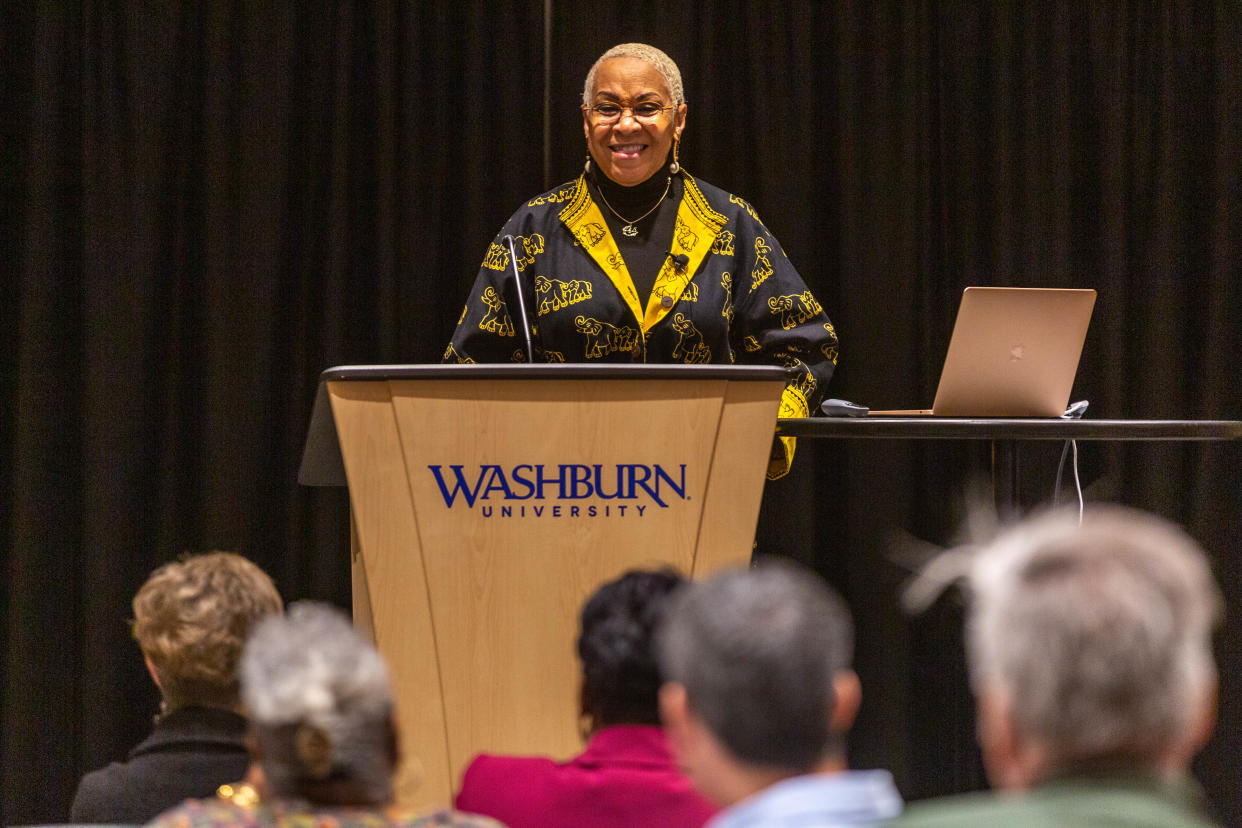How can U.S. heal racial trauma? Start by understanding it: Washburn speaker Joy DeGruy

Few people understand — or even know — that the chains around the Statue of Liberty's feet carry the huge weight on the nation's collective conscience.
But Joy DeGruy now knows better.
It was her scholarship as a social scientist and race historian that led her to discover that the statue's designer, French sculptor Frédéric Auguste Bartholdi, had originally meant for the broken chains to be held in Lady Liberty's left hand, as a dedication to America's achievement in ending the institution of slavery.
That symbolism, though, was tempered down by the American people of the Reconstruction-era, and the chains were hidden away above the barely seen pedestal, rather than Liberty's left hand. Over time, the statue came to celebrate immigrants instead — the inscription calling for the world to send its poor, tired and huddled masses was not added until nearly 30 years after the statue's construction.
It's history like this that must be recovered and remembered if the country is to really reckon with its racial wounds and scars, DeGruy said Wednesday evening to a Washburn University Memorial Union room full of students and community members.
For subscribers:At momentous time for Washburn, who will newly installed president JuliAnn Mazachek be?
DeGruy, an internationally renowned researcher and educator on the topic of intergenerational and historical trauma, was the university's keynote speaker as part of its WUmester initiative.
WUmesters are a topic picked each spring for university-wide programming and class discussions on topics that can connect their classes to real-world concepts and issues. The spring 2023 WUmester topic is "health and healing."
Joy DeGruy's work has focused on Post Traumatic Slave Syndrome
DeGruy has formally studied racism, trauma, violence and American chattel slavery for over 30 years, but her experiences with the concepts started when she was a child.
Then, she saw how others — including other Black family members and friends — used the word "Black" as a weapon, meant to insult and diminish.
That led her on a path to study the lingering trauma that underlays that type of rhetoric, and it led her to later write "Post Traumatic Slave Syndrome: America's Legacy of Enduring Injury and Healing." In her book, DeGruy asserts that the the effects of slavery's discrimination are still visible today — that even after abolition, slavery's discrimination and oppression morphed into anti-Black codes, Jim Crow laws and segregation.
Among Black communities, slavery's effects live on in Black children's diminished self-esteem and anger at a lack of respect, she argues.
More:Kansas lawmakers seek university funding info on diversity, equity, critical race theory
While she doesn't explicitly label her work as such, DeGruy's scholarship shares many of the tenets of critical race theory, in that it uses the concept of race to examine social institutions and power imbalances.
In early 2022, the principal of Derby High School was forced to publicly apologize after members of the girls basketball team were shown a video on the concept of white privilege featuring DeGruy.
DeGruy said incidents like that are proof that the U.S. is "a country that screams for change, but we go out kicking and screaming when it comes to change." She said she sees proof, however, that the country is on the precipice of change, as race-related protests and riots continue to increase in frequency.
"That's when you know we're on the precipice of change, and when the change occurs, we will be totally different people," she said. "But this resistance will get ugly, and even more ugly than we can imagine. I would have never even imagined we'd be pushed back to Jim Crow in 2023."
History as a form of healing
When you go to the doctor, the first thing a nurse does is take a patient's medical history in order to deeply understand the current ailment or injury, Degruy said.
The same should be true of any attempts to reckon with America's troubled past and faults, DeGruy argued. In fact, a 10-week graduate course she teaches about racial justice and healing does not even begin to discuss healing until about the 10th week, after she works with students through a long list of the country's failures to be equitable to all.
In addition to the Statue of Liberty's hidden chains, DeGruy shared other examples of history barely taught to U.S. children, such as Malcolm X, the Trail of Tears, and the true extent and barbarism of chattel slavery.
More:Kansas turned a Black vocational school into a prison. Topeka activist wants it returned.
"We have been miseducated, undereducated and in some ways, not educated at all," she said.
Quoting from "Caste: The Origin of Our Discontents," DeGruy shared author Isabel WIlkerson's analogy likening of modern America to an old, inherited house that is now falling down on racial and economic lines.
But if America can understand how it got to this point, then maybe it can also understand how to get out.
"This is a collective healing," DeGruy said. "It's not mine or yours — it's ours. This is our house, and it is falling apart. We can't be squeamish, and we can't get in our feelings about this. We have to understand that this is a collective healing that we must do, and all of us must heal, because all of us are injured by this."
Rafael Garcia is an education reporter for the Topeka Capital-Journal. He can be reached at rgarcia@cjonline.com or by phone at 785-289-5325. Follow him on Twitter at @byRafaelGarcia.
This article originally appeared on Topeka Capital-Journal: Joy DeGruy speaks on racial trauma, healing at Washburn University

